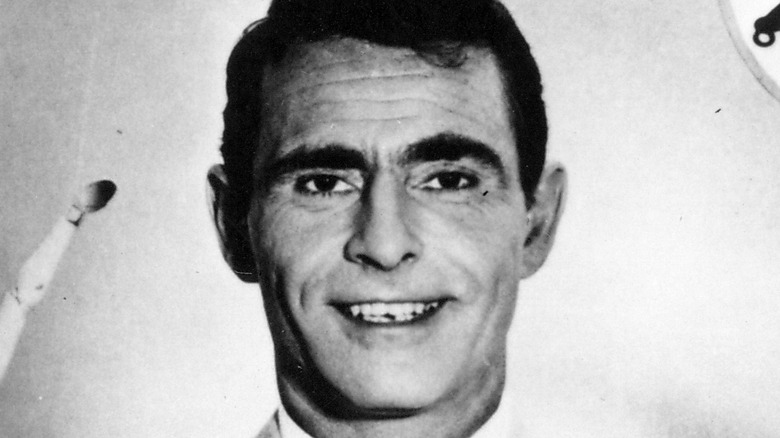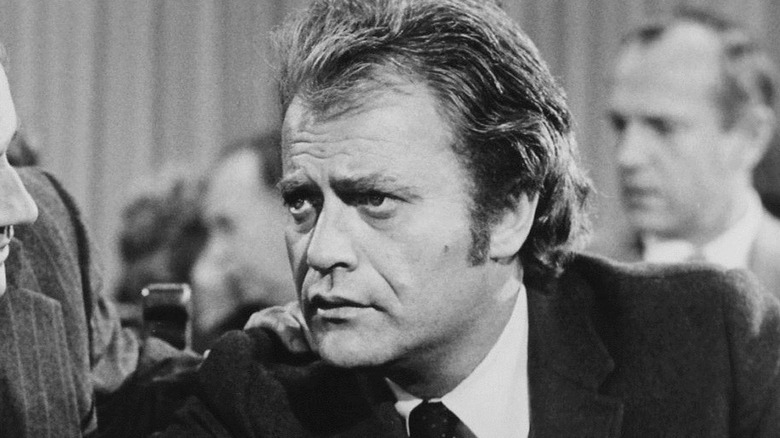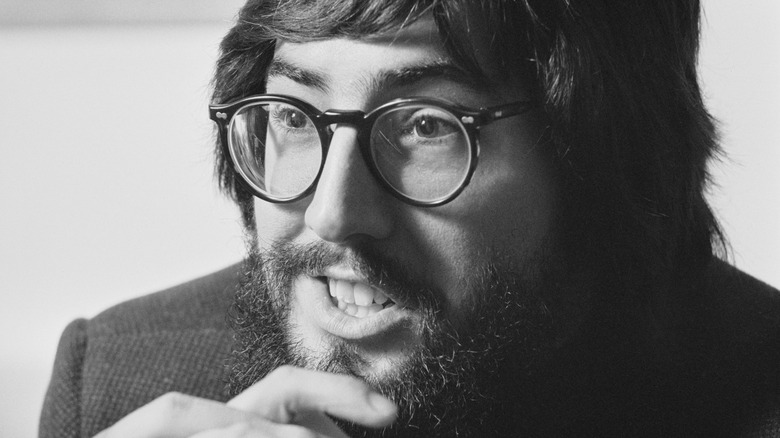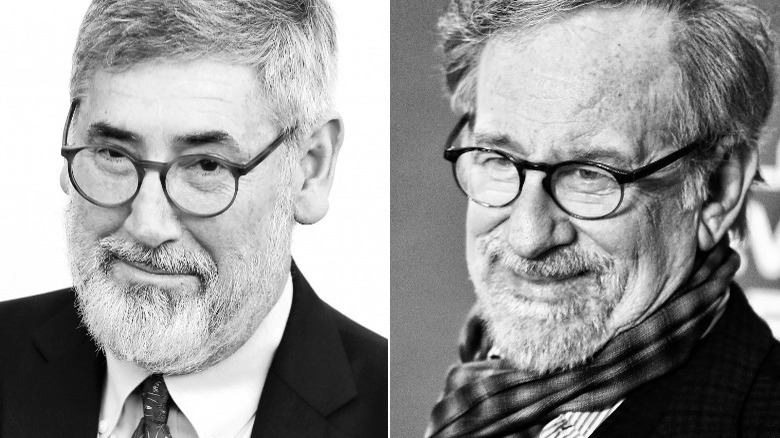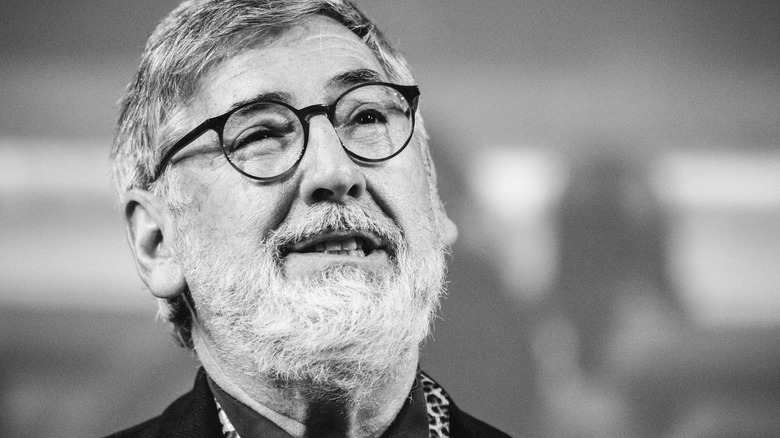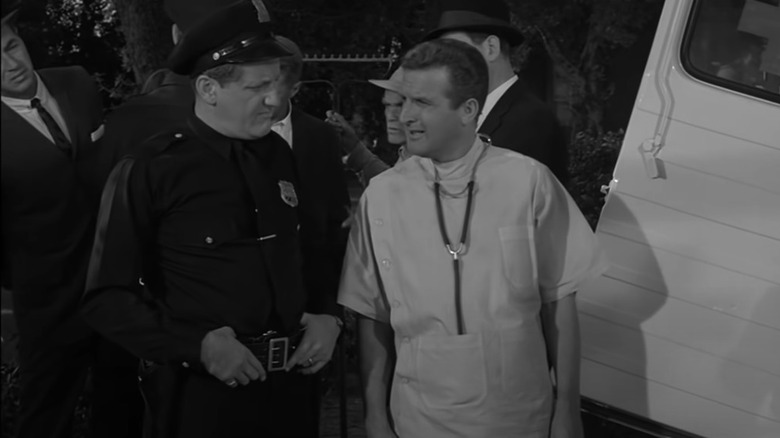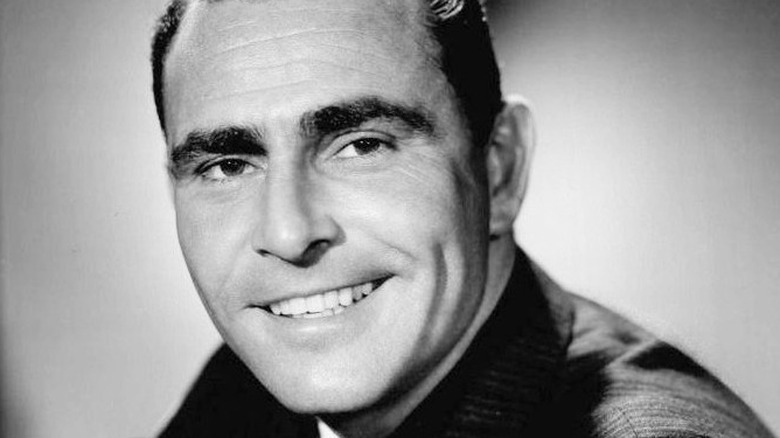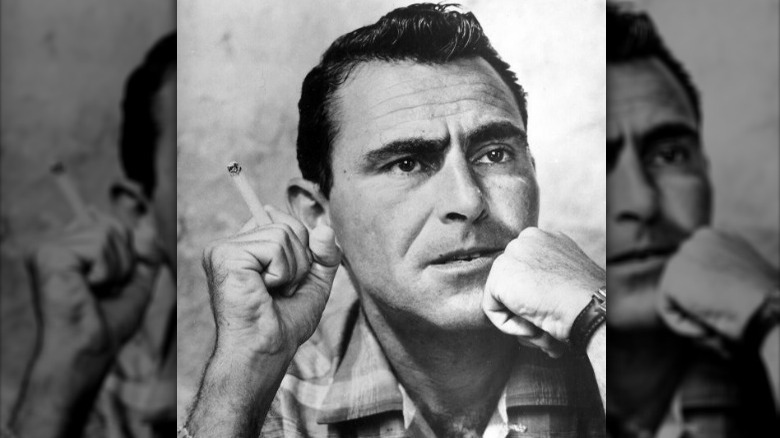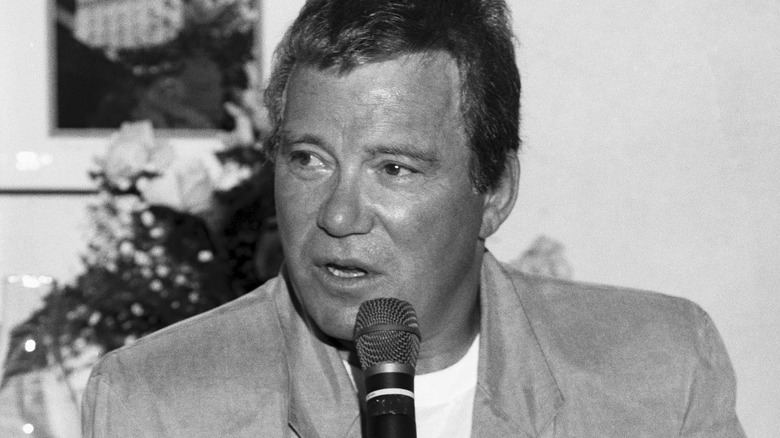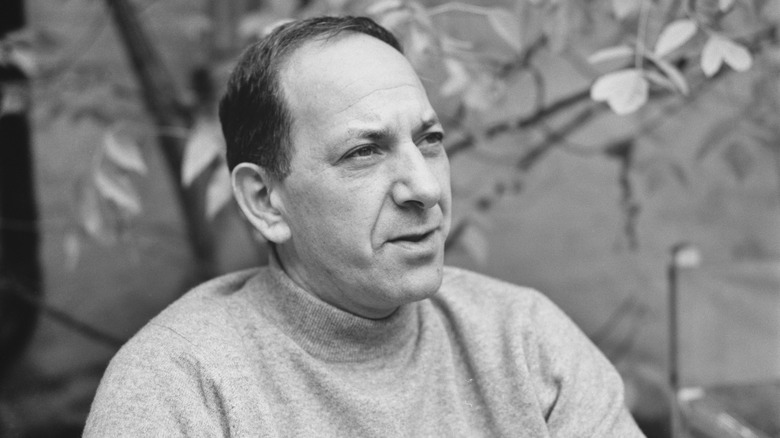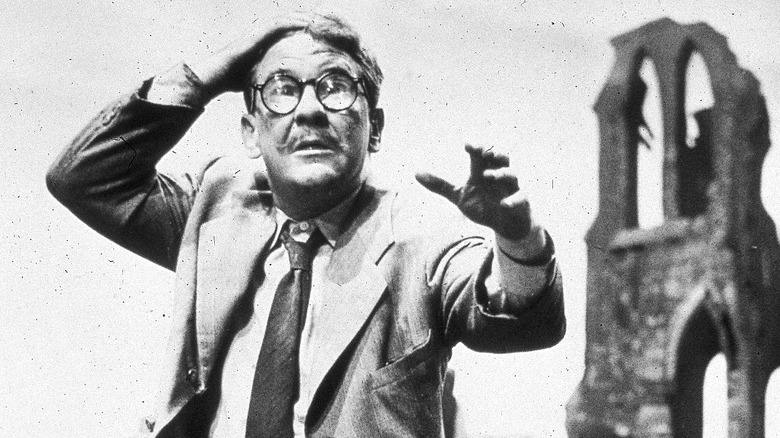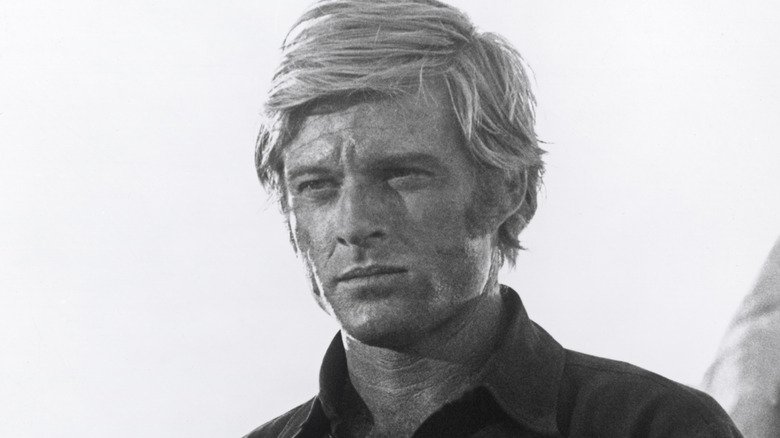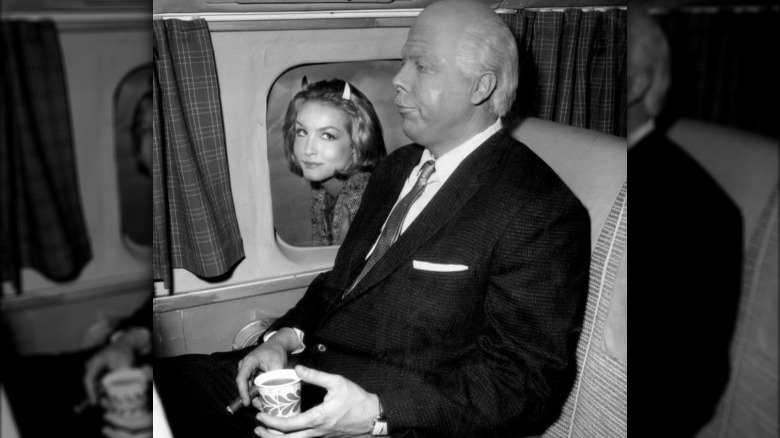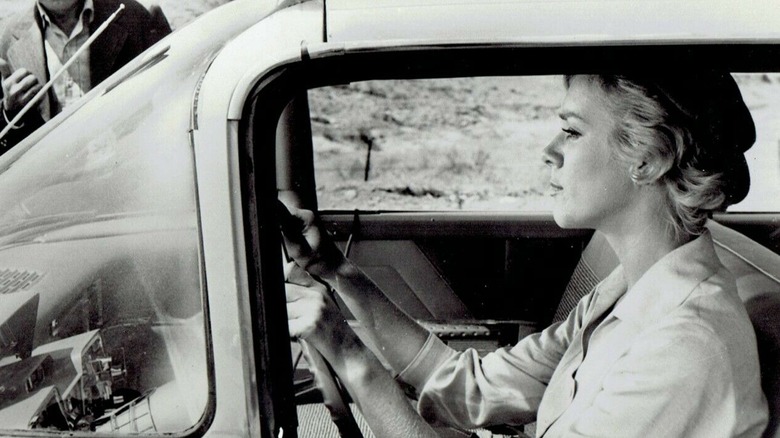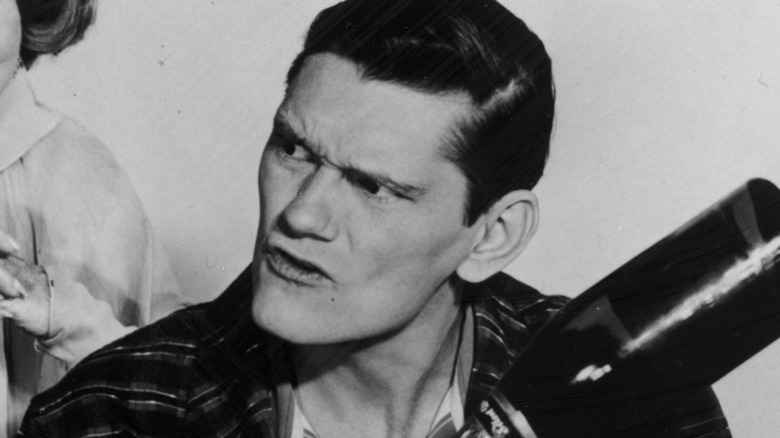Tragic Details About The Cast Of The Twilight Zone
When one mentions "The Twilight Zone," it's hard not to think of creator Rod Serling's original opening narration: "There is a fifth dimension, beyond that which is known to man ... It is an area which we call The Twilight Zone." Both fascinating and chilling, from 1959 to 1964, the cult hit captivated audiences with provocative plots, twist endings, and mind-boggling episodes.
Considered a groundbreaking anthology series, showrunner Serling seemingly never ran out of ideas to bring to the small screen. "You could say many of the stories were written in my mind," the screenwriter once mused, noting that he had wanted to start a project as vast as the sci-fi hit for years (via "A Critical History of Television's The Twilight Zone"). Once CBS finally said goodbye to the series in the '60s, it was brought to collective consciousness again two decades later, with the 1983 release of "Twilight Zone: The Movie," and again in 2019, with Jordan Peele's reboot of the series, which lasted a year.
Of course, it's the original show that's left a lasting legacy in the world of TV and film, and with over 150 episodes filmed during its runtime, "The Twilight Zone" has seen a lot of actors come and go. Sadly, some of its stars have dealt with real-life horrors off-camera — not to mention the catastrophic accident that happened during the making of the movie, too. These are the tragic details about the cast of "The Twilight Zone."
The movie adaptation saw a disastrous accident happen on set
When fans of the original "Twilight Zone" series heard they would be getting a movie adaptation in 1983, they were delighted. Divided into four segments by four acclaimed directors (Steven Spielberg, Joe Dante, Joe Miller, and John Landis), three of the stories were remakes from the original show, but Landis' tale was his own — and resulted in a catastrophe.
According to History, on the final day of shooting in July 1982, one scene saw actor Vic Morrow rescue two children (played by Renee Shinn Chen and Myca Dinh Le) from an American air raid during the Vietnam War. After getting the kids to safety, Morrow's character was supposed to deliver the line, "I'll keep you safe, kids. I promise" (via Slate). Sadly, the veteran actor never uttered those words. While the three stars were running away from a helicopter, the explosions happening on the set caused the pilot to lose control of his aircraft and crash into the actors. Per Slate, Morrow accidentally dropped Chen, causing part of the helicopter to fall on the 6-year-old before its blade sliced through Morrow and Dinh Le.
As it turned out, the man operating the helicopter, Dorcey Wingo, was a real Vietnam War vet, who was terrified of performing the scene after witnessing the explosions going off during rehearsals. Landis, who was known for his volatile temper on set if things didn't go his way, was the reason Wingo decided to remain silent about his concerns.
Twilight Zone: The Movie broke child labor laws
The heartbreaking accident that saw three actors dead (two of which were children) on the "Twilight Zone: The Movie" set came with one positive: it changed the way Hollywood looked at risk management and labor laws.
According to Crime Library, for John Landis' soon-to-be-tragic segment in the flick, he ran into a snag: the child labor laws in California. When Landis and his associate producer met with casting agents, they told them that the scene involving live explosives and a helicopter seemed a bit dicey. After some back and forth, the two men decided not to use the casting agency and instead went their own ways to hire the child stars — illegally (via Crime Library). Forgoing any waivers that would approve the kids working late at night, Landis also paid them under the table in cash.
After the on-set disaster took the lives of both child stars and Vic Morrow, Warner Bros. Vice President John Silvia decided to spearhead a change in filming safety, starting a committee that created rulings for various safety hazards on set. "The committee had to parse words like 'would, shall, and must' because of the possibility of negligence lawsuits overtaking Hollywood if they were too strict in the wording," recalled Chris Palmer, who was part of the committee, to Slate. To this day, these safety rules are in a manual now known as the Injury and Illness Prevention Program.
John Landis and Steven Spielberg's friendship was severed after Twilight Zone: The Movie
"Twilight Zone: The Movie" came to fruition thanks to Steven Spielberg. According to Crime Library, the storied director had the idea for a film adaptation in 1981, asking his friend and fellow director John Landis to come on board the project as equal co-producers and partners. Sadly, the tragic helicopter accident during Landis' segment of the flick forever ruined the pair's rapport.
Per CineAwesome, Spielberg was distraught that Landis decided to use live ammunition for the scene that ultimately took three lives and was incredibly close to even abandoning the project entirely (via "The Binge Watcher's Guide to The Twilight Zone"). Although the ending for the Landis-directed portion was re-written, this didn't mean anything changed between the shamed director and Spielberg. "They were good friends, Landis and Spielberg," recalled Leonard Levine, the attorney for Landis' unit production manager, to the Los Angeles Times. "After this incident, Spielberg never spoke to him, [and] would not return his calls."
It wasn't just Spielberg who shunned his former pal, however. According to Levine, some of Landis' friends turned their backs on the filmmaker as well, refusing to be seen with him in public after the subsequent manslaughter trial.
The accident on Twilight Zone: The Movie resulted in a 10-month trial
After the deadly helicopter accident that claimed three lives on the set of "Twilight Zone: The Movie," director John Landis and four other men were off to trial on charges of involuntary manslaughter (via History). The trial lasted 10 long months, where the prosecution asserted that Landis and the crew violated child labor laws and had a general recklessness for the working conditions, which led to the disaster.
During the preliminary hearing, Shyan Huei Chen, one of the mothers of the adolescent victims, recounted the tragedy through tears, noting that she at one point even asked if the on-set explosions were safe. "It is not dangerous, only noise," associate producer George Folsey reportedly told her (via The New York Times). According to a scathing article about the trial by the Chicago Tribune, Landis allegedly refused to take any responsibility for what happened — an observation backed up by a 1987 interview with the director for the Los Angeles Times. "Believe me, I feel that accident very strongly ... But I realized this has nothing to do with me," he declared to the outlet.
Remarkably, all five men were acquitted at the end of the dramatic trial, with the jury taking nine days to reach their decision, per The New York Times. Of course, the families of all three victims filed subsequent lawsuits against Warner Bros. and co-producers Steven Spielberg and Landis, all of which were settled for undisclosed amounts (via History).
Jay Overholts' tragic death had an eerie similarity to his Twilight Zone roles
Jay Overholts was a relative unknown in Hollywood, having only appeared in three different series in his incredibly short career. He graced the small screen in eight episodes of "The Twilight Zone," including the very first one, 1959's "Where Is Everybody?" Having worked with showrunner Rod Serling in the past for another anthology series, "Playhouse 90," who knows if the professional pals would have collaborated again before Overholts' untimely death in 1966.
However, what's interesting about the actor's cause of death is the eerie similarities it had with two episodes of the sci-fi series he starred in. According to MeTV, a 1960 episode, "A Thing About Machines," saw Overholts play an ambulance man that shows up at the scene of a car accident where the protagonist was run over by a possessed vehicle (similar to Stephen King's cult horror novel, "Christine"). A year later, the star appeared in an episode titled "The Jungle," where a cursed man discovers a taxi driver (Overholts) slumped over in his vehicle, dead.
The last time Overholts appeared in an episode of "The Twilight Zone" was in 1962. A mere four years later, he was dead. As detailed in The Cincinnati Enquirer, the actor's death was the result of a car accident near Malibu, California. He was only 43.
Rod Serling was exhausted churning out episodes of The Twilight Zone
From the moment production began on "The Twilight Zone" in 1959, the show's creator, Rod Serling, truly gave it his all. As revealed in "A Critical History of Television's The Twilight Zone," for a grueling six months before the series debut, he would get up at five or six in the morning and immediately begin reciting his scripts into a tape recorder. These days would last 12 to 14 hours, and it would take him about three to four days to complete a single script.
While Serling was undoubtedly ecstatic at the creative opportunities that came by way of his hit sci-fi series, there's no doubt that his demanding schedule was taking a toll on him. "When I bend down to pick up a pencil, I'm five days behind," he once quipped (via The New Atlantis). Nevertheless, Serling kept writing, and by the time the show was canceled in 1964, he had written a whopping 92 episodes.
Sadly, even by 1961, Serling was experiencing severe burnout, to the point where his involvement in the show began declining. "I've never felt quite so drained of ideas as I do at this moment ... I've written so much I'm woozy," he was quoted as saying, per "A Critical History of Television's The Twilight Zone." At least some good came out of Serling's legendary ideas. For his work on "The Twilight Zone," Serling was awarded a Golden Globe and three Primetime Emmys.
Rod Serling's life after The Twilight Zone was brief and tragic
The fifth and final season of "The Twilight Zone" wasn't considered as strong as the previous ones — in part because of the arrival of William Froug. According to "A Critical History of Television's The Twilight Zone," Froug was a writer, producer, and director in Hollywood with quite the resume, yet the episodes he produced didn't exactly fit in with older seasons of "The Twilight Zone" — relying more on gimmicky shticks, which led to a severe decline in viewership. "For one reason or another, [president of CBS] Jim Aubrey decided he was sick of the show," claimed Froug. The series was canceled in 1964.
So, what happened to showrunner Rod Serling after "The Twilight Zone?" As detailed by The Buffalo News, the writer struggled to find steady work, jumping from project to project, including a show called "Night Gallery," which many dubbed a poor version of his cult classic. Sadly, it looks like the lack of success heavily affected Serling, who began drinking more and smoked around four cigarette packs a day. Near the end of his life, Serling also began teaching writing classes at Ithaca College in New York, per The New York Times. On June 28, 1975, "The Twilight Zone" legend died during open heart surgery, at the age of 50.
If you or anyone you know is struggling with addiction issues, help is available. Visit the Substance Abuse and Mental Health Services Administration website or contact SAMHSA's National Helpline at 1-800-662-HELP (4357).
William Shatner's third marriage ended in tragedy
Two-time "Twilight Zone" actor and "Star Trek" icon William Shatner has been married four times, and his union to his third wife Nerine Kidd ended in heartbreaking tragedy. CNN reports that in August 1999, Shatner arrived home to find Kidd floating in their pool, dead. An autopsy later revealed that Kidd's blood-alcohol level was over three times the legal limit for California drivers. The cause of death was accidental drowning, due to a broken neck, per People.
In Shatner's 2018 autobiography, "Live Long And ...: What I Learned Along the Way," he revealed that Kidd was struggling with alcoholism throughout their two-year marriage. The actor had hoped he could help Kidd overcome her addiction. "There is no way to accurately convey that level of pain to anyone else," Shatner wrote. "My grief was overwhelming."
After the release of his book, Shatner spoke to the National Enquirer about his grief, going into further detail about the struggles of his third marriage, and how he filed for divorce a year before Kidd's death (via Radar Online). It turned out that she was known to hide bottles of vodka in their home, or in water bottles. Although Shatner ended up trying to save their marriage after serving his wife divorce papers, a mere days before Kidd's death, he told her he had given up.
If you or anyone you know is struggling with addiction issues, help is available. Visit the Substance Abuse and Mental Health Services Administration website or contact SAMHSA's National Helpline at 1-800-662-HELP (4357).
Jack Klugman lost his voice to throat cancer
Jack Klugman is best remembered as Oscar, one half of "The Odd Couple," or the titular character in his crime series, "Quincy M.E." An actor for an impressive six decades, Klugman also appeared in four episodes of "The Twilight Zone" in the early 1960s. And while he made countless fans laugh as the iconic Oscar, the actor also faced great hardships in his life off-camera.
According to The Oral Cancer Foundation, Klugman was born into a low-income family in South Philadelphia, Pennsylvania, and his father died when he was still a young boy. As a means to provide for her six children, Klugman's mother fashioned hats in the evening to sell to well-off women, while the future actor would buy products from street vendors and resell them in dangerous neighborhoods.
As Klugman later found success as an actor, he began smoking heavily (his character in "The Odd Couple" was frequently seen with a cigarette), and sadly, in 1974, he discovered he had cancer of the larynx. By 1989, Klugman had surgery to remove his cancer — but he also lost his right vocal cord, as well. Per "Retirement Is For Sissies," the star then embarked on an agonizing rehabilitation process to get his voice back for six months, resulting in his subsequent husky tone. Remarkably, Klugman continued acting for decades after beating cancer, finally dying peacefully in December 2012, at age 90 (via Entertainment Weekly).
Burgess Meredith had no fond memories of his childhood
With a whopping 182 credits to his name, Burgess Meredith played countless supporting characters throughout his long-lasting career, appearing in the "Rocky" films as boxing coach Mickey Goldmill, "Grumpy Old Men," and "Clash of the Titans" in 1981. As for his connection to "The Twilight Zone," the actor took part in four episodes and was also the narrator in the 1983 film (although his voice was uncredited).
While Meredith was a well-respected star both in Hollywood and on Broadway (via TCM), his climb to the top of the A-list was grueling. In 1994, The Washington Post reviewed the actor's biography, "So Far, So Good," highlighting Meredith's tumultuous childhood. As it turned out, the future thespian's father was an alcoholic, while he described his mother as a woman "in constant despair." Not too close to his parents, Meredith was sent to multiple private schools and was flat broke in his early adult years, leading him from Cleveland to New York, where he began his stage career.
"All my life, to this day, the memory of my childhood remains grim and incoherent," the actor recalled in his book (via The Washington Post). "If I close my eyes and think back, I see little except violence and fear." In his golden years, Meredith suffered from Alzheimer's disease and cancer, dying in 1997 at the age of 89.
If you or anyone you know is struggling with addiction issues, help is available. Visit the Substance Abuse and Mental Health Services Administration website or contact SAMHSA's National Helpline at 1-800-662-HELP (4357).
Robert Redford believes that death follows him
Beloved Hollywood icon and founder of the Sundance Film Festival, Robert Redford has left his mark on cinema since the early 1960s, both in front of the camera and behind it. In the early years of his career when he was still breaking into Tinseltown, Redford also appeared in one 1962 episode of "The Twilight Zone," titled "Nothing in the Dark."
As adored as he is (and as charming as his characters are), Redford has been plagued by tragedy both in his youth and as an adult. "He has gone through one hell of a life," explained the actor's biographer of 14 years, Michael Feeney Callan, to Closer, noting that the actor suffered numerous familial heartbreaks. Redford's mother, who died when he was a teen, had a stillbirth with twins while the future star was still young. Redford also looked at his uncle as a father figure, yet he died fighting in World War II. "I always had this thing that death was on my shoulder, 24/7," mused the actor in his book, "Robert Redford: The Biography," adding, "My dogs, as a kid. My uncle. My mom ... a darkness right on top of me."
Sadly, death only followed Redford as he got older. His first son with wife Lola van Wagenen died after a mere 10 weeks from Sudden Infant Death Syndrome, while his second, James, died at the age of 58 in 2020 due to bile-duct cancer in his liver (via Vanity Fair).
Albert Salmi was part of a murder-suicide
Albert Salmi was a respected actor both in Hollywood and on Broadway, and he guest-starred in three episodes of "The Twilight Zone" (via The New York Times). Per The Spokesman-Review, Salmi had a relatively calm upbringing, growing up in Brooklyn with Finnish parents. After joining the military in World War II, he returned to America and used the G.I. Bill to obtain a grant at the Actors Studio with Lee Strasburg, launching his acting career.
Throughout the '50s and '60s, Salmi was a staple in Tinseltown, yet he grew tired of the environment he thrust himself and his family in. "He hated that whole scene," recalled his daughter, Jennifer LaRue, to The Spokesman-Review. By the mid-1980s, the brood moved to Spokane, Washington. And while Salmi may have hated the glitz and glam of Hollywood, his home life was what was particularly alarming.
According to The Spokesman-Review, in February 1990, Salmi's wife filed for divorce, citing her husband's alcoholism and violence as the root problems. According to LaRue, however, her mother was abusive, as well. Only a few months later, in April, an unthinkable tragedy occurred: both Salmi and his wife were found dead in their home, with the actor reportedly shooting his wife and then turning the gun on himself (via The New York Times).
If you or someone you know is dealing with domestic abuse, you can call the National Domestic Violence Hotline at 1−800−799−7233. You can also find more information, resources, and support at their website.
Inger Stevens suffered from long-lasting loneliness
Blonde beauty Inger Stevens nabbed some iconic roles in Hollywood throughout the '50s and '60s, notably appearing as Katrin "Katy" Holstrum in the ABC sitcom "The Farmer's Daughter." She also snagged some high-profile men during her time in Tinseltown, too, such as her fling with "Man on Fire" co-star Bing Crosby (via The New York Times). And yet, with her gorgeous looks and apparent talent (she even took acting lessons from Lee Strasberg), Stevens was haunted by an unshakable sadness throughout her life.
According to The New York Times, Stevens was born in Stockholm, Sweden, but moved to America with her father after her parents' divorce. The effects of coming from a broken home certainly took a toll on the star, who in an interview once declared, "I am constantly feeling lonely." Luck wasn't on Stevens' side, either, and throughout her life, she survived a plane crash, suffered carbon monoxide poisoning on the set of "Cry Terror," and dislocated her jaw while filming a TV show.
In 1959, after an isolating New Year's Eve party, Stevens attempted suicide for the first time. In April 1970, she completed suicide and was found dead in her home (via The New York Times).
If you or anyone you know is having suicidal thoughts, please call the National Suicide Prevention Lifeline at 1-800-273-TALK (8255).
An on-set injury left Dick York with a lifelong addiction
Best remembered as Darrin Stephens on "Bewitched," Dick York was a phenomenal entertainer. Primarily starring in TV shows during his career, York also appeared in two episodes of "The Twilight Zone" in the early 1960s. Sadly, York's life rapidly changed after he departed the hit series that made him a household name, and, according to Biography, fans were floored when they saw Dick Sargent replace him in the role of Stephens in Season 6. So, what happened?
As York explained to FilmFax (via Biography), he suffered a brutal back injury while on the set of 1959's "They Came to Cordura." The actor was moving a handcar along railway tracks, and when the director stopped the scene, one of the extras grabbed the rail York was using. "I was suddenly, jarringly, lifting his entire weight off the flatbed — 180 pounds or so," York revealed. He was taken to the hospital and given painkillers — which was when his addiction began.
Although York attempted to continue working with a growing addiction, he finally collapsed in 1969 on the set of "Bewitched," which subsequently led to his departure from the sitcom and Hollywood, in general. By the '70s, York was living on welfare, and the following decade, his emphysema (due to decades of heavy smoking) meant he required oxygen from a canister to live. York died at the age of 63 in 1992 (via Biography).
If you or anyone you know is struggling with addiction issues, help is available. Visit the Substance Abuse and Mental Health Services Administration website or contact SAMHSA's National Helpline at 1-800-662-HELP (4357).
